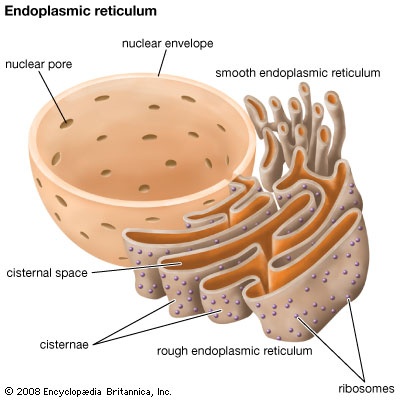endoplasmic reticulum
biology
 in biology, a continuous membrane system that forms a series of flattened sacs within the cytoplasm of a eukaryotic cell and is important in the biosynthesis, processing, and transport of proteins (protein) and lipids. The ER usually constitutes more than half of the membranous content of the cell and is continuous with the outer membrane of the nuclear envelope. The close association of the ER with the nucleus facilitates communication about protein processing. This allows the ER to rapidly send signals to the nucleus when problems in the biosynthesis and folding of proteins occur and thus influences the overall rate of translation of proteins in the nucleus. The ER has two distinct regions. The first, called the rough ER (RER), named for its rough appearance due to the ribosomes attached to its outer cytoplasmic surface, is found in the region of the ER immediately associated with the nuclear envelope. The RER synthesizes secretory proteins, phospholipids, and membrane. The second region of the ER, the smooth ER (SER), is not associated with ribosomes. The SER is involved in the synthesis of lipids and the detoxification of some toxic chemicals. The sarcoplasmic reticulum is a specialized SER that regulates the calcium ion concentration in the cytoplasm of striated muscle cells. See also cell.
in biology, a continuous membrane system that forms a series of flattened sacs within the cytoplasm of a eukaryotic cell and is important in the biosynthesis, processing, and transport of proteins (protein) and lipids. The ER usually constitutes more than half of the membranous content of the cell and is continuous with the outer membrane of the nuclear envelope. The close association of the ER with the nucleus facilitates communication about protein processing. This allows the ER to rapidly send signals to the nucleus when problems in the biosynthesis and folding of proteins occur and thus influences the overall rate of translation of proteins in the nucleus. The ER has two distinct regions. The first, called the rough ER (RER), named for its rough appearance due to the ribosomes attached to its outer cytoplasmic surface, is found in the region of the ER immediately associated with the nuclear envelope. The RER synthesizes secretory proteins, phospholipids, and membrane. The second region of the ER, the smooth ER (SER), is not associated with ribosomes. The SER is involved in the synthesis of lipids and the detoxification of some toxic chemicals. The sarcoplasmic reticulum is a specialized SER that regulates the calcium ion concentration in the cytoplasm of striated muscle cells. See also cell.- Mosley, Sir Oswald, 6th Baronet
- Mosley, Walter
- mosque
- Mosque-Cathedral of Córdoba
- Mosque of Aḥmad ibn Ṭūlūn
- Mosque of Selim
- Mosque ofʿ Amr ibn al-ʿĀṣ
- Mosquera, Tomás Cipriano de
- Mosquito
- mosquito
- Mosquito Coast
- mosquito fern
- mosquito fish
- Moss
- moss
- Mossad
- moss agate
- moss animal
- Moss, Carlton
- Moss Hart
- Moss, Howard
- Mossi
- Mossi states
- Mossoró
- Most